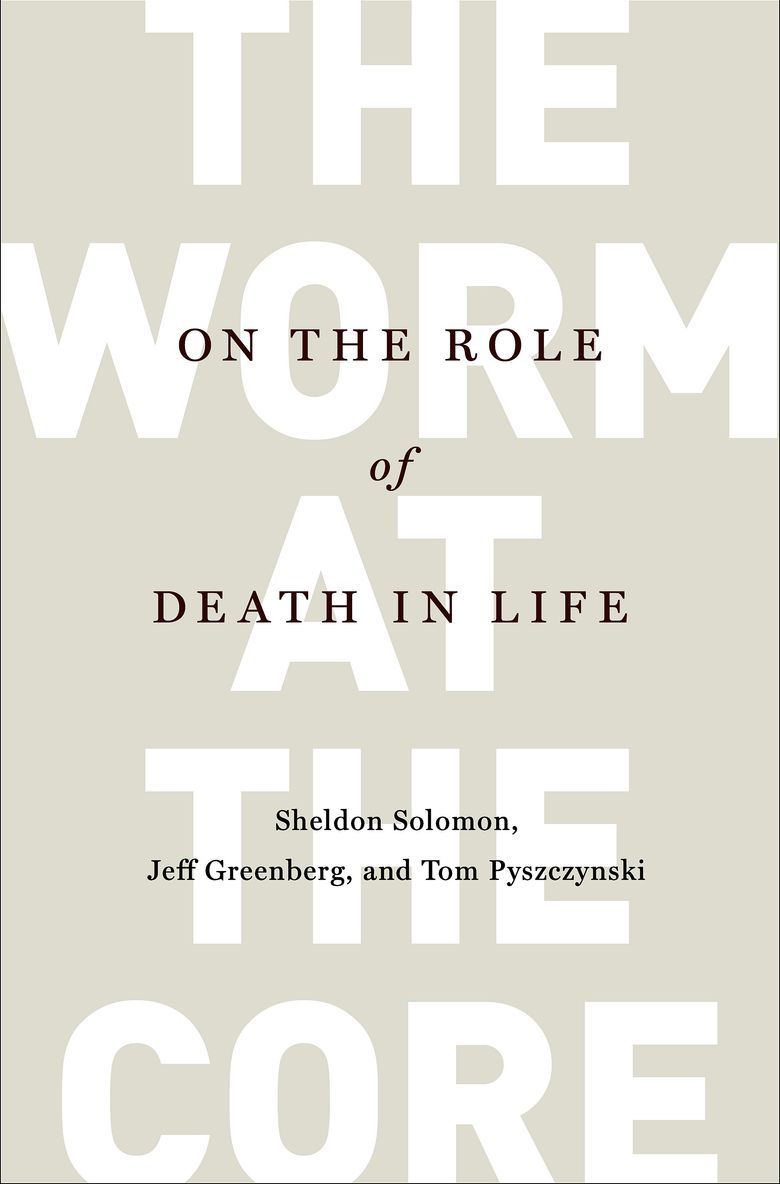
Sheldon Solomon, Jeff Greenberg, and Tom Pyszczynski, The Worm at the Core: On the Role of Death in Life, Random House, 2015.
A transformative, fascinating theory—based on robust and groundbreaking experimental research—reveals how our unconscious fear of death powers almost everything we do, shining a light on the hidden motives that drive human behavior.
More than one hundred years ago, the American philosopher William James dubbed the knowledge that we must die “the worm at the core” of the human condition. In 1974, cultural anthropologist Ernest Becker won the Pulitzer Prize for his book The Denial of Death, arguing that the terror of death has a pervasive effect on human affairs. Now authors Sheldon Solomon, Jeff Greenberg, and Tom Pyszczynski clarify with wide-ranging evidence the many ways the worm at the core guides our thoughts and actions, from the great art we create to the devastating wars we wage.
The Worm at the Core is the product of twenty-five years of in-depth research. Drawing from innovative experiments conducted around the globe, Solomon, Greenberg, and Pyszczynski show conclusively that the fear of death and the desire to transcend it inspire us to buy expensive cars, crave fame, put our health at risk, and disguise our animal nature. The fear of death can also prompt judges to dole out harsher punishments, make children react negatively to people different from themselves, and inflame intolerance and violence.
But the worm at the core need not consume us. Emerging from their research is a unique and compelling approach to these deeply existential issues: terror management theory. TMT proposes that human culture infuses our lives with order, stability, significance, and purpose, and these anchors enable us to function moment to moment without becoming overwhelmed by the knowledge of our ultimate fate. The authors immerse us in a new way of understanding human evolution, child development, history, religion, art, science, mental health, war, and politics in the twenty-first century. In so doing, they also reveal how we can better come to terms with death and learn to lead lives of courage, creativity, and compassion.
Written in an accessible, jargon-free style, The Worm at the Core offers a compelling new paradigm for understanding the choices we make in life—and a pathway toward divesting ourselves of the cultural and personal illusions that keep us from accepting the end that awaits us all.
“The idea that nearly all human individual and cultural activity is a response to death sounds far-fetched. But the evidence the authors present is compelling and does a great deal to address many otherwise intractable mysteries of human behaviour. This is an important, superbly readable and potentially life-changing book. . . . The lesson contained within The Worm at the Core suggests one should confront mortality in order to live an authentic life, as the Epicureans and the Stoics suggested many centuries ago.”—The Guardian
“A neat fusion of ideas borrowed from sociology, anthropology, existential philosophy and psychoanalysis . . . [The] sweep-it-under-the-carpet approach to death is facile and muddle-headed. More than that, it has consequences more far-reaching than we could possibly imagine because, as [the authors] see it, death informs practically every aspect of human existence. From the way we organise our societies to the moral codes we live by, even down to how we have sex and what rituals and emotions we ascribe to it, death is the bedrock.”—The Herald
“Deep, important, and beautifully written, The Worm at the Core describes a brilliant and utterly original program of scientific research on a force so powerful that it drives our lives, but so frightening that we cannot think clearly about it. This book asks us to, compels us to, and then shows us how—by shining the light of reason on the heart of human darkness.”—Daniel Gilbert
Social psychologists Solomon, Greenberg, and Pyszczynski provide an intriguing but uneven volume aimed at lay readers that attempts to show that humanity’s unique awareness of death “has a profound and pervasive effect on our thoughts, feelings, and behaviors in almost every domain of human life—whether we are conscious of it or not.” They cite a number of interesting experiments that contrast the behavior of subjects made more aware of mortality with those who are not. Readers might be surprised to learn that judges belonging to the first category sentenced prostitutes more harshly than their colleagues in the second. The authors explain that those forced to think “about their own mortality [react] by trying to do the right thing as prescribed by their culture.” The language sometimes lapses into cliché (“We have a lot to learn from the ancients”) or overstatement. For all the book’s arguments, some readers will arrive at the end unconvinced that every instance of human cruelty to other humans “stems from humankind’s fundamental intolerance of... those who subscribe to different cultural worldviews.” - Publishers Weekly
Ernest Becker’s The Denial of Death (1973) made the striking claim that human activity is driven largely by unconscious efforts to deny and transcend mortality. “We build character and culture in order to shield ourselves from the devastating awareness of underlying helplessness and terror of our inevitable death,” observed Becker. The authors of The Worm at the Core extended Becker’s work with a presentation in 1984 at a meeting of the Society of Experimental Social Psychology. They called it “Terror Management Theory”. The reception was lukewarm. As the authors recount, “renowned psychologists were storming for the exits”.
Undeterred, they approached the journal of the American Psychological Association with a paper on the theory of terror management. The editor insisted their ideas wouldn’t be taken seriously unless some hard evidence could be provided (Becker’s work was built largely around psychoanalytic theory rather than empirical research).
The authors spent the next 25 years measuring the influence of the fear of death on human affairs. The results not only confirmed Becker’s speculation but built on it. “Over the course of human history,” they write, “the terror of death has guided the development of art, religion, language, economics and science. It raised the pyramids in Egypt and razed the Twin Towers in New York.”
The book addresses the two pillars of terror management – cultural worldviews and self-esteem. To demonstrate how fears about death influence societal opinion, judges were prompted to set a bail figure nine times higher for a (putative) prostitute after being reminded of death. This, and substantial other evidence, suggests that reminders of death accentuate our negative feelings towards those who do not share our values. The closer our death fears are to the surface, the more we cleave to social norms – not necessarily those of wider society, but any group we have chosen to identify with (on this definition even support for, say, Islamic State, is an assertion of a “social norm” and therefore an extension of our “immortality projects”. Suicide bombers ultimately act out of fear of death).
Consciousness of death also, crucially, feeds into people’s assessment of their own worth. “Unlike the baboon who gluts himself only on food, man nourishes himself mostly on self-esteem,” wrote Becker in The Birth and Death of Meaning (1962). Intriguingly, the greater your fear of death, the lower your self-esteem – and vice versa. Self-esteem provides psychological protection against existential terror.
The book also charts the history of man’s relationship with death, asserting that it was primary in creating civilisation. Religion did not develop as an offshoot of settled society – it seems probable that the earliest settlements, marking the stage of human development from hunter gathering to agriculture, were built around sites of ritual and worship. The need for immortality predated the requirement of settled economic activity. Strategies for denying death have been there since the dawn of human cognition – the cave paintings at Chauvet, dating back 30,000 years, featured spirit realms and depictions of the supernatural world.
In the modern secular world, we seek to overcome death through fringe cod-scientific activities such as cryogenics. More subtly, we convince ourselves that scientific progress, by curing cancer, or finding a way to upload a human personality on to a hard disk, will rescue us from oblivion. Meanwhile, we distract ourselves from our mortal terror – which would impair functional human activity were it allowed free rein – by working hard, staying busy, shopping and entertainment. Or we seek immortality via the everyday heroism of our jobs, by means of our children who will carry our genes forward, or through connections with our ancestors (hence our obsession with the family tree). For those who have the capacity to create, works of art and invention will stand as our legacy.
The idea that nearly all human individual and cultural activity is a response to death sounds far-fetched. But the evidence the authors present is compelling and does a great deal to address many otherwise intractable mysteries of human behaviour. This is an important, superbly readable and potentially life-changing book – if uncomfortable at times. The lesson contained within The Worm at the Core suggests one should confront mortality in order to live an authentic life, as the Epicureans and the Stoics suggested many centuries ago.
Denial does not remove the problem of death – it merely buries it. This can lead not only to an intractable and inflexible worldview, but collective neuroticism – all in the service of creating an effective psychological barrier against reality. Yet for those with courage and clear-sightedness, facing up to our common destinies can mark a kind of rebirth. As Camus wrote: “Face up to death. Thereafter anything is possible.” - Tim Lott
Given the inevitability of death and its power to render human life meaningless, why read a book about this existential quandary, the authors of such a book ask.
Furthermore, they ask, why write it?
“The Worm at the Core: On the Role of Death in Life,” by Sheldon Solomon, Jeff Greenberg and Tom Pyszczynski (Random House), was written by three professors of psychology who have set out to show that death — and more accurately the foreknowledge and fear of it — influence all human behavior. How humans manage the terror of death has “raised the pyramids in Egypt and razed the twin towers in Manhattan,” according to the authors.
They have written a book to try to prove it — and one worth reading.
For them, the recognition of the power of death in life comes from Ernest Becker, a cultural anthropologist who died in Burnaby, B.C., in 1974, two months before his book “The Denial of Death” won the Pulitzer Prize. Becker argued that unconscious efforts to deny and transcend death are behind much of human activity.
For them, the recognition of the power of death in life comes from Ernest Becker, a cultural anthropologist who died in Burnaby, B.C., in 1974, two months before his book “The Denial of Death” won the Pulitzer Prize. Becker argued that unconscious efforts to deny and transcend death are behind much of human activity.
Judges asked to describe their emotions about their own deaths were more harsh in sentencings than the neutral group. People reminded of death were more susceptible to charismatic political candidates. Give Americans a death reminder and they are more likely to apply stereotypes to those different from themselves.
All these experiments involve the ways humans have devised to keep death at bay, constructing “cultural world views” that give a sense of meaning and then operating successfully within those constructs to provide self-esteem, another key to believing that life is worth living.
Explaining each experiment to show another aspect of “terror-management theory” makes the book somewhat repetitious. But whether you believe the experiments offer definitive proof of how the fear of death shapes human behavior, there is insight here about how and why we live our lives.
The book’s language is straightforward and even light at times, making a weighty subject approachable.
The three psychologists’ exploration delves into religion, sex, mental illness and our conscious and unconscious defenses deployed to ward off the fear of death. That includes efforts, often desperate and perhaps silly, to achieve immortality through means both literal (for $80,000 you can have your head frozen for a chance at a second time around) and symbolic (my name will be remembered as long as this review is read).













